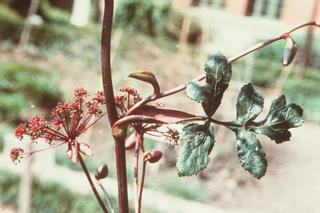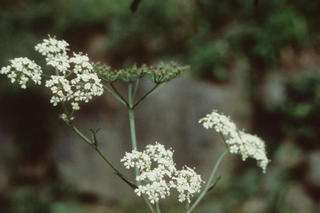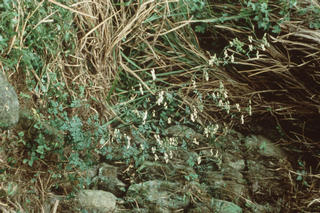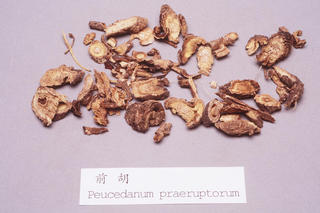Peucedanum praeruptorum
Contents
Nomenclature
Other Names:
Historical Use of Peucedanum praeruptorum
Peucedanum praeruptorum in Traditional Chinese Medicine
Background
Nenqianhu ÄÛÇ°ºú
Chinese Name (pinyin): Qianhu
Chinese Name :
Common Name :Peucedanum Root
Specific Name : Radix peucedani
Scientific Name:
Collection : The drug is collected in winter and next spring, when stem and leaves wither or before floral stem grows, remove from rootlet, wash clean and dried in the sun or at a low temperature.
Description : Root of Peucedanum praeruptorum: Irregular cylindrical, conical or fusiform, slightly twisted, the lower part frequently branched. 3 - 15 cm long, 1 - 2 cm in diameter. Externally blackish brown or greyish yellow frequently with stem scars and fibrous remains of pericladia at the root stock with numerous fine annular striations at the upper end and longitudinally furrowed or wrinkled with transverse lenticels at the lower part. Texture relatively flexible, hard when dried, easily broken, fracture uneven, pale yellowish white. Numerous brownish yellow oily spots scattered in cortex, cambium ring brown, rays radiated. Odour aromatic, taste slightly bitter and pungent.
Identification : 1.Macerate 1 g of the powder in 10 ml of ether for 2 hours. Apply 2 drops of the ether solution respectively to two pieces of filter paper. Examine under ulktra violet light (365 nm), a pale blue fluorescence is shown. Add several drops of 15% sodium hydroxide solution on the spots. the fluorescence disappears after 2 minutes. Protect one piece of filter paper from light and expose to other one to light and examine under ultra violet light after about 3 hours, the spot on the paper exposed to the light shows an intensively blue fluorescence and the spot protected from light shows no fluorescence.2.Heat under reflux 5 g of the powder in 30 ml of ethanol for 10 minutes and filter. Evaporate 2 ml of the filtrate to dryness, Dissolve the residue in 1 ml of glacial acetic acid then add 5 drops of acetyl chloride and a few crystal of zinc chloride and heat on a water bath for 1 - 2 minutes. A red color is producedExtractives: Carry out the cold maceration methanol as described under the determination of ethanol soluble extractives (Appendix X A), using 50% ethanol as the solvent not less than 20.0%.
Processing : Eliminate foreign matter, wash clean, soften thoroughly, cut into thin slices and dry in the sun.Processed with honey: Stir fry the slices as described under the method for stir frying with honey (Appendix ll D) until not sticky to the fingers.
Action : To dispel wind and remove heat, and to relieve cough and resolve phlegm.
Indication : cough and dyspnea in respiratory infections with copious or yellowish sticky expectoration
Precautions :
Dosage : 3 to 9 g.
Storage : Preserve in cool nd dry place, protected from mould and moth.
Synonymns for Peucedanum praeruptorum
Patent Medicines and Medicines with Multiple Ingredients that include Peucedanum praeruptorum
Pharmaceutical Information
Chemical Constituents
Evidence or the Use of Peucedanum praeruptorum in the Treatment of Epilepesy
Basic Science
Animal Studies
Cohort, Case-Control and Non-Randomized Trials
Randomized Controlled Trials
Meta-Analysis
1st Five Results: pubmed search
Qiongxiao Wang, Qingmei Sun, Qinger Huang, Luping Qin, Bo Zhu
##Title##
Front Pharmacol: 2024, 15;1352657
[PubMed:38633612]
[WorldCat.org]
[DOI]
(P e)
Yu Guo, Guang Xu, Shun Luo, Min Luo, Dan Yang, Qiu-Sheng Tan, Yong-Dong Yang, Cai-Fu Deng
[Metabolomics of quality formation of different cultivars of Peucedanum praeruptorum].
Zhongguo Zhong Yao Za Zhi: 2024, 49(3);681-690
[PubMed:38621872]
[WorldCat.org]
[DOI]
(P p)
Kai-Qin Lin, Han-Fei Liu, Chao Chen, Jin-Yu Li, Wei-Dong Pan, Chao Sun, Hua-Yong Lou
Structurally Diverse Coumarins from Peucedanum praeruptorum and their Anti-Inflammatory Activities via NF-κB Signaling Pathway.
Chem Biodivers: 2024, 21(3);e202400184
[PubMed:38372676]
[WorldCat.org]
[DOI]
(I p)
Yucheng Zhao, Yuedong He, Liangliang Han, Libo Zhang, Yuanzheng Xia, Fucheng Yin, Xiaobing Wang, Deqing Zhao, Sheng Xu, Fei Qiao, Yibei Xiao, Lingyi Kong
Two types of coumarins-specific enzymes complete the last missing steps in pyran- and furanocoumarins biosynthesis.
Acta Pharm Sin B: 2024, 14(2);869-880
[PubMed:38322336]
[WorldCat.org]
[DOI]
(P p)
Cheng Song, Yingyu Zhang, Muhammad Aamir Manzoor, Peipei Wei, Shanyong Yi, Shanshan Chu, Zhenzhen Tong, Xiangwen Song, Tao Xu, Fang Wang, Huasheng Peng, Cunwu Chen, Bangxing Han
A chromosome-scale genome of Peucedanum praeruptorum provide insights into Apioideae evolution and medicinal ingredient biosynthesis.
Int J Biol Macromol: 2024, 255;128218
[PubMed:37992933]
[WorldCat.org]
[DOI]
(I p)



